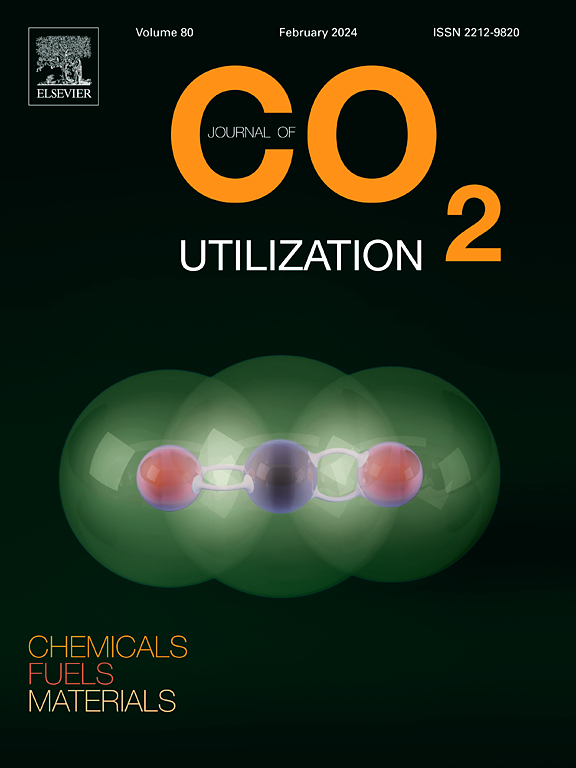High-temperature slag engineering in pursuit of effective mineral carbonation of pyroxene-rich ferronickel slag
IF 8.4
2区 工程技术
Q1 CHEMISTRY, MULTIDISCIPLINARY
引用次数: 0
Abstract
The search for resources for low-carbon construction materials and valorization pathways for industrial residues go hand in hand. Mineral carbonation has been abundantly studied to strive for a net-zero CO2 construction sector. Ferronickel slags have been studied for the production of other cementitious materials, but have inferior carbonation potential due to their low Ca-content. This work shows that the reactivity of a pyroxene-rich ferronickel slag towards CO2 can be substantially increased using high-temperature slag engineering. Using a combination of CaCO3 additions and slow cooling, the produced compacts made from synthesized slags acquire a compressive strength of 30–40 MPa after carbonation at 10 bar CO2 and 60 °C for 16 hours. The reactivity towards CO2 originates from the formation of akermanite (Ca2MgSi2O7) during slag modification with > 20 wt% CaCO3. The compressive strength is dependent on the particle size distribution of the modified slag and carbonation time. Although the reaction degree of akermanite is high after 6 hours of carbonation, a significant strength increase is still seen after carbonation for 16 and 48 hours. The carbonation process forms a binding phase composed of aragonite and a CaMg-carbonate which might be high Mg-calcite or protodolomite. The CO2 balance of the overall process shows a substantially lower value compared to Portland clinker-based cements, but additional efforts are required to develop an optimum net-zero CO2 process.
高温炉渣工程,追求富辉石镍铁炉渣的有效矿物碳化
寻找低碳建筑材料资源和工业残渣的价值化途径是相辅相成的。为努力实现二氧化碳净零排放的建筑行业,对矿物碳化进行了大量研究。铁镍矿渣已被研究用于生产其他胶凝材料,但由于其钙含量低,碳化潜力较差。这项研究表明,利用高温炉渣工程可以大幅提高富含辉石的镍铁合金炉渣对二氧化碳的反应性。通过添加 CaCO3 和缓慢冷却相结合的方法,在 10 bar CO2 和 60 °C 下碳化 16 小时后,由合成炉渣制成的压实物可获得 30-40 MPa 的抗压强度。对 CO2 的反应性源于炉渣改性过程中形成的赤铁矿(Ca2MgSi2O7)。抗压强度取决于改性炉渣的粒度分布和碳化时间。虽然碳化 6 小时后赤铁矿的反应程度较高,但碳化 16 和 48 小时后强度仍有显著提高。碳化过程形成了由文石和钙镁碳酸盐组成的结合相,后者可能是高镁方解石或原多罗莫石。与基于波特兰熟料的水泥相比,整个工艺的二氧化碳平衡值要低得多,但要开发出最佳的净零二氧化碳工艺还需要更多的努力。
本文章由计算机程序翻译,如有差异,请以英文原文为准。
求助全文
约1分钟内获得全文
求助全文
来源期刊

Journal of CO2 Utilization
CHEMISTRY, MULTIDISCIPLINARY-ENGINEERING, CHEMICAL
CiteScore
13.90
自引率
10.40%
发文量
406
审稿时长
2.8 months
期刊介绍:
The Journal of CO2 Utilization offers a single, multi-disciplinary, scholarly platform for the exchange of novel research in the field of CO2 re-use for scientists and engineers in chemicals, fuels and materials.
The emphasis is on the dissemination of leading-edge research from basic science to the development of new processes, technologies and applications.
The Journal of CO2 Utilization publishes original peer-reviewed research papers, reviews, and short communications, including experimental and theoretical work, and analytical models and simulations.
 求助内容:
求助内容: 应助结果提醒方式:
应助结果提醒方式:


